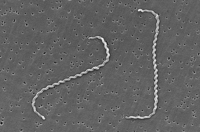
Photo from wikipedia
Background The role of rodents in Leptospira epidemiology and transmission is well known worldwide. Rats are known to carry different pathogenic serovars of Leptospira spp. capable of causing disease in… Click to show full abstract
Background The role of rodents in Leptospira epidemiology and transmission is well known worldwide. Rats are known to carry different pathogenic serovars of Leptospira spp. capable of causing disease in humans and animals. Wild rats (Rattus spp.), especially the Norway/brown rat (Rattus norvegicus) and the black rat (R. rattus), are the most important sources of Leptospira infection, as they are abundant in urban and peridomestic environments. In this study, we compiled and summarized available data in the literature on global prevalence of Leptospira exposure and infection in rats, as well as compared the global distribution of Leptospira spp. in rats with respect to prevalence, geographic location, method of detection, diversity of serogroups/serovars, and species of rat. Methods We conducted a thorough literature search using PubMed without restrictions on publication date as well as Google Scholar to manually search for other relevant articles. Abstracts were included if they described data pertaining to Leptospira spp. in rats (Rattus spp.) from any geographic region around the world, including reviews. The data extracted from the articles selected included the author(s), year of publication, geographic location, method(s) of detection used, species of rat(s), sample size, prevalence of Leptospira spp. (overall and within each rat species), and information on species, serogroups, and/or serovars of Leptospira spp. detected. Findings A thorough search on PubMed retrieved 303 titles. After screening the articles for duplicates and inclusion/exclusion criteria, as well as manual inclusion of relevant articles, 145 articles were included in this review. Leptospira prevalence in rats varied considerably based on geographic location, with some reporting zero prevalence in countries such as Madagascar, Tanzania, and the Faroe Islands, and others reporting as high as >80% prevalence in studies done in Brazil, India, and the Philippines. The top five countries that were reported based on number of articles include India (n = 13), Malaysia (n = 9), Brazil (n = 8), Thailand (n = 7), and France (n = 6). Methods of detecting or isolating Leptospira spp. also varied among studies. Studies among different Rattus species reported a higher Leptospira prevalence in R. norvegicus. The serovar Icterohaemorrhagiae was the most prevalent serovar reported in Rattus spp. worldwide. Additionally, this literature review provided evidence for Leptospira infection in laboratory rodent colonies within controlled environments, implicating the zoonotic potential to laboratory animal caretakers. Conclusions Reports on global distribution of Leptospira infection in rats varies widely, with considerably high prevalence reported in many countries. This literature review emphasizes the need for enhanced surveillance programs using standardized methods for assessing Leptospira exposure or infection in rats. This review also demonstrated several weaknesses to the current methods of reporting the prevalence of Leptospira spp. in rats worldwide. As such, this necessitates a call for standardized protocols for the testing and reporting of such studies, especially pertaining to the diagnostic methods used. A deeper understanding of the ecology and epidemiology of Leptospira spp. in rats in urban environments is warranted. It is also pertinent for rat control programs to be proposed in conjunction with increased efforts for public awareness and education regarding leptospirosis transmission and prevention.
Journal Title: PLoS Neglected Tropical Diseases
Year Published: 2019
Link to full text (if available)
Share on Social Media: Sign Up to like & get
recommendations!